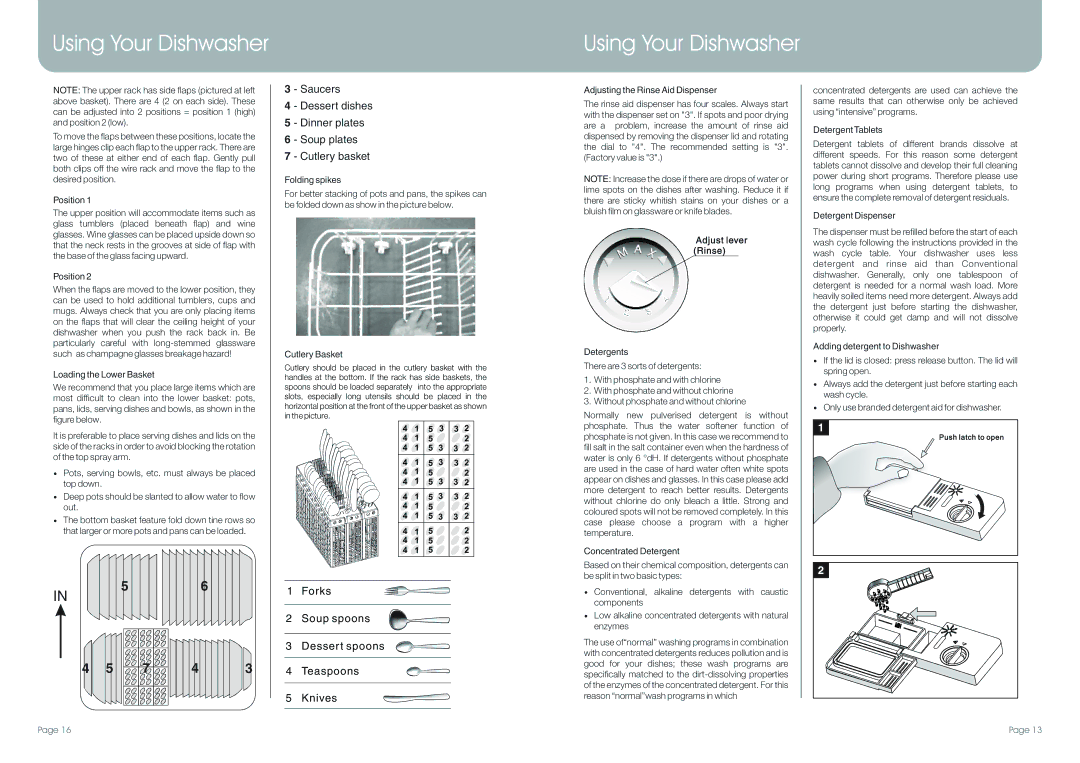NOTE: The upper rack has side flaps (pictured at left above basket). There are 4 (2 on each side). These can be adjusted into 2 positions = position 1 (high) and position 2 (low).
To move the flaps between these positions, locate the large hinges clip each flap to the upper rack. There are two of these at either end of each flap. Gently pull both clips off the wire rack and move the flap to the desired position.
Position 1
The upper position will accommodate items such as glass tumblers (placed beneath flap) and wine glasses. Wine glasses can be placed upside down so that the neck rests in the grooves at side of flap with the base of the glass facing upward.
Position 2
When the flaps are moved to the lower position, they can be used to hold additional tumblers, cups and mugs. Always check that you are only placing items on the flaps that will clear the ceiling height of your dishwasher when you push the rack back in. Be particularly careful with long-stemmed glassware such as champagne glasses breakage hazard!
Loading the Lower Basket
We recommend that you place large items which are most difficult to clean into the lower basket: pots, pans, lids, serving dishes and bowls, as shown in the figure below.
It is preferable to place serving dishes and lids on the side of the racks in order to avoid blocking the rotation of the top spray arm.
ŸPots, serving bowls, etc. must always be placed top down.
ŸDeep pots should be slanted to allow water to flow out.
ŸThe bottom basket feature fold down tine rows so that larger or more pots and pans can be loaded.
5 6
IN
3 - Saucers
4 - Dessert dishes
5 - Dinner plates
6 - Soup plates
7 - Cutlery basket
Folding spikes
For better stacking of pots and pans, the spikes can be folded down as show in the picture below.
Cutlery Basket
Cutlery should be placed in the cutlery basket with the handles at the bottom. If the rack has side baskets, the spoons should be loaded separately into the appropriate slots, especially long utensils should be placed in the horizontal position at the front of the upper basket as shown in the picture.
4 | 1 | 5 | 3 | 3 | 2 |
4 | 1 | 5 | | | 2 |
4 | 1 | 5 | 3 | 3 | 2 |
| | | | | |
4 | 1 | 5 | 3 | 3 | 2 |
4 | 1 | 5 | | | 2 |
4 | 1 | 5 | 3 | 3 | 2 |
| | | | | |
4 | 1 | 5 | 3 | 3 | 2 |
4 | 1 | 5 | | | 2 |
4 | 1 | 5 | 3 | 3 | 2 |
4 | 1 | 5 | | | 2 |
4 | 1 | 5 | | | 2 |
4 | 1 | 5 | | | 2 |
| | | | | |
1 Forks
2Soup spoons
3Dessert spoons 
4Teaspoons 
5Knives 
Adjusting the Rinse Aid Dispenser
The rinse aid dispenser has four scales. Always start with the dispenser set on "3". If spots and poor drying are a problem, increase the amount of rinse aid dispensed by removing the dispenser lid and rotating the dial to "4". The recommended setting is "3". (Factory value is "3".)
NOTE: Increase the dose if there are drops of water or lime spots on the dishes after washing. Reduce it if there are sticky whitish stains on your dishes or a bluish film on glassware or knife blades.
Adjust lever (Rinse)
Detergents
There are 3 sorts of detergents:
1.With phosphate and with chlorine
2.With phosphate and without chlorine
3.Without phosphate and without chlorine
Normally new pulverised detergent is without phosphate. Thus the water softener function of phosphate is not given. In this case we recommend to fill salt in the salt container even when the hardness of water is only 6 °dH. If detergents without phosphate are used in the case of hard water often white spots appear on dishes and glasses. In this case please add more detergent to reach better results. Detergents without chlorine do only bleach a little. Strong and coloured spots will not be removed completely. In this case please choose a program with a higher temperature.
Concentrated Detergent
Based on their chemical composition, detergents can be split in two basic types:
ŸConventional, alkaline detergents with caustic components
ŸLow alkaline concentrated detergents with natural enzymes
The use of“normal” washing programs in combination with concentrated detergents reduces pollution and is good for your dishes; these wash programs are specifically matched to the dirt-dissolving properties of the enzymes of the concentrated detergent. For this reason “normal”wash programs in which
concentrated detergents are used can achieve the same results that can otherwise only be achieved using “intensive” programs.
Detergent Tablets
Detergent tablets of different brands dissolve at different speeds. For this reason some detergent tablets cannot dissolve and develop their full cleaning power during short programs. Therefore please use long programs when using detergent tablets, to ensure the complete removal of detergent residuals.
Detergent Dispenser
The dispenser must be refilled before the start of each wash cycle following the instructions provided in the wash cycle table. Your dishwasher uses less detergent and rinse aid than Conventional dishwasher. Generally, only one tablespoon of detergent is needed for a normal wash load. More heavily soiled items need more detergent. Always add the detergent just before starting the dishwasher, otherwise it could get damp and will not dissolve properly.
Adding detergent to Dishwasher
ŸIf the lid is closed: press release button. The lid will spring open.
ŸAlways add the detergent just before starting each wash cycle.
ŸOnly use branded detergent aid for dishwasher.

